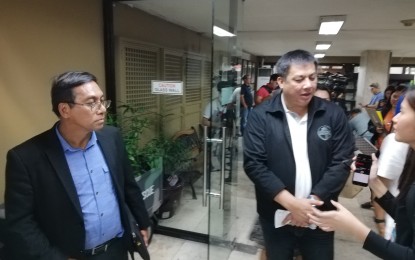
MANILA – The Metro Manila Council (MMC) on Friday reminded its 17 local government units (LGUs) to strengthen their disaster response capabilities to be better prepared for “The Big One,” or the possible 7.2 magnitude earthquake coming from the West Valley Fault.
In an interview following an MMC meeting, Metropolitan Manila Development Authority (MMDA) general manager Jose Arturo “Jojo” Garcia said in the wake of such a disaster, communications and roads will be severely damaged which would necessitate disaster response at a local level.
“Sabi ng DPWH (Department of Public Works and Highways), lahat ng bridge masisira yan. So ‘yung mga quadrants natin, pagtibayin (The DPWH said all bridges would be destroyed. So, all quadrants must be strengthened),” Garcia said.
He said that during the meeting, the Philippine Institute for Volcanology and Seismology (Phivolcs) presented different scenarios that could occur during such an earthquake, and that the occurrence of such a disaster was only a matter of time.
“Pinakita rin nila dito na (They showed that) it’s not about if, kung darating ba o matutuloy ba ang big one (if it will come or will the big one happen). It’s a matter of when,” Garcia said.
In an interview, Phivolcs Officer-in-Charge Dr. Renato Solidum said it is not only the LGUs in Metro Manila but also those in neighboring provinces that need to be able to respond to large-scale disasters.
“Masigurado dapat ng mga bayan, ng mga siyudad, na kaya nilang rumisponde on their own initially. Kasi yung mga magreresponde na identified from the regions, kailangan pa ng oras para makarating (It must be ensured by towns and cities that they are capable of responding on their own initially. Because other response teams from the regions, they’ll need time to reach them),” Solidum said.
He underscored the importance of strengthening an LGU’s partnership and coordination with their identified responding LGUs to ensure mutual preparedness.
“Maganda yung ibinalita ng Pasig City, na meron silang pakikipag-usap sa Region 2 — Isabela and Quirino — na ngayong Pebrero ay magkakaroon sila ng pagsasanay. Isa yan sa mga priority ng local government (Pasig City delivered good news, that they have a plan with the Region 2 — Isabela and Quirino — in February to have an exercise. That’s one of the priorities of the local government),” Solidum said.
In case of strong earthquake, Metro Manila would likely be divided into four quadrants that would each have emergency operation centers (EOC).
During the Metro Manila Shake Drill in July last year, the western quadrant — composed of Navotas, Malabon, and Manila — used the Intramuros Golf Course as its EOC while the northern quadrant — composed of Quezon City, Caloocan, Valenzuela, and San Juan — used the Veterans Memorial Medical Center Golf Course.
The eastern quadrant — composed of Marikina and Pasig — utilized the LRT-2 Santolan Depot while the southern quadrant — composed of Pasay, Makati, Parañaque, Las Piñas, Muntinlupa, Pateros, and Taguig – converged at the Villamor Golf Course.